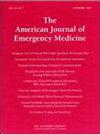急诊科住院病人的住院和临床结果:一项倾向匹配的研究
IF 2.2
3区 医学
Q1 EMERGENCY MEDICINE
引用次数: 0
摘要
目的:本研究评估了在急诊科(寄宿生)和直接入院(非寄宿生)的住院患者的临床结果。方法回顾性倾向匹配研究,对明尼苏达州东南部22家急诊科和17家医院的连续成年人进行回顾性倾向匹配研究。暴露变量为ED登机。急诊科登机被定义为由急诊科医生标记入院并等待住院床位的患者,而不管标记的时间。主要结局是住院时间(LOS)和住院死亡率。次要终点是住院后90天内的全因死亡率。使用86个协变量将寄宿生与非寄宿生进行匹配。泊松、logistic和Cox回归模型用于评估相关性,并按年龄、性别和ED位置进行亚组分析。结果2019年4月1日至2024年3月30日,急诊科就诊821244人次,入院151834人次(26.9%)。其中3173例(1.9%)为寄宿生(中位时间:4.2 h; IQR为1.8-9.7)。寄宿与住院死亡率(OR, 0.84; 95% CI, 0.59-1.20; P = 0.340)或LOS (IRR, 1.02; 95% CI, 0.99-1.04; P = 0.088)无关,但与较高的90天死亡率相关(HR, 1.30; 95% CI, 1.15-1.46; P = 0.005)。这些发现在年龄、性别和ED位置上是一致的。结论:在这项多中心、倾向评分匹配的研究中,急诊科入住与LOS或住院死亡率无关,但与90天死亡率增加1.3倍相关,这在年龄、性别和急诊科位置上是一致的。本文章由计算机程序翻译,如有差异,请以英文原文为准。
Inpatient boarding in the emergency departments and clinical outcomes: A propensity-matched study
Objectives
The study evaluated clinical outcomes in patients who experienced inpatient boarding in the ED (boarders) compared to those admitted directly (non-boarders).
Methods
Retrospective propensity-matched study of consecutive adults presented to 22 emergency departments and were subsequently admitted to 17 hospitals across Southeast Minnesota. The exposure variable was ED boarding. ED boarding was defined as patients flagged by ED physicians for admission and awaiting an inpatient bed, regardless of the time to flagging. The primary outcomes were length of hospital stay (LOS) and in-hospital mortality. The secondary outcome was all-cause mortality within 90 days after hospitalization. Boarders were matched to non-boarders using 86 covariates. Poisson, logistic, and Cox regression models were used to assess associations, with subgroup analyses by age, sex, and ED location.
Results
From April 1, 2019, to March 30, 2024, 821,244 ED visits and 151,834 (26.9 %) admissions. Of these, 3173 (1.9 %) were boarders (median time: 4.2 h; IQR, 1.8–9.7). Boarding was not associated with in-hospital mortality (OR, 0.84; 95 % CI, 0.59–1.20; P = 0.340) or LOS (IRR, 1.02; 95 % CI, 0.99–1.04; P = 0.088), but was associated with higher 90-day mortality (HR, 1.30; 95 % CI, 1.15–1.46; P = 0.005). These findings were consistent across age, sex, and ED location.
Conclusions
In this multicenter, propensity score–matched study, ED boarding was not associated with LOS or in-hospital mortality but was associated with a 1.3-fold increase in 90-day mortality, consistent across age, sex, and ED location.
求助全文
通过发布文献求助,成功后即可免费获取论文全文。
去求助
来源期刊
CiteScore
6.00
自引率
5.60%
发文量
730
审稿时长
42 days
期刊介绍:
A distinctive blend of practicality and scholarliness makes the American Journal of Emergency Medicine a key source for information on emergency medical care. Covering all activities concerned with emergency medicine, it is the journal to turn to for information to help increase the ability to understand, recognize and treat emergency conditions. Issues contain clinical articles, case reports, review articles, editorials, international notes, book reviews and more.

 求助内容:
求助内容: 应助结果提醒方式:
应助结果提醒方式:


